

68 Circular Road, #02-01 049422, Singapore
Revenue Tower, Scbd, Jakarta 12190, Indonesia
4th Floor, Pinnacle Business Park, Andheri East, Mumbai, 400093
Cinnabar Hills, Embassy Golf Links Business Park, Bengaluru, Karnataka 560071
Connect With Us
Financial Super-Apps in the West: User Growth, Cross-Sell Rates & Revenue per Active User (2025–2030)
Financial super-apps in the West are rapidly evolving, driven by increasing user adoption, enhanced cross-selling capabilities, and improved revenue per active user (ARPU). This report explores the projected growth of super-apps between 2025 and 2030, including key trends in user acquisition, service diversification, and profitability metrics. With a focus on the U.S. and European markets, this report provides a detailed analysis of their strategic positioning in the fintech space.

What's Covered?
Report Summary

What is the projected user growth rate for financial super-apps in the West between 2025 and 2030?
Financial super-apps in the West are projected to experience significant user growth between 2025 and 2030, with active users increasing from 500 million to 900 million. This represents a 12% compound annual growth rate (CAGR) driven by the adoption of integrated services and the rise of younger, digital-native consumers. As more users sign up for a variety of services, super-apps will increasingly become central to their financial lives, contributing to their rapid expansion.

How will cross-sell rates evolve as financial super-apps expand their service offerings?
Cross-sell rates in financial super-apps are expected to grow as the platforms expand their offerings. Super-apps are integrating additional services, such as insurance, lending, and wealth management, into their ecosystems. This shift will increase the average number of services used per user, improving user engagement and boosting revenue. By 2030, the cross-sell rate is expected to rise from 2.5 to 4.2, driven by more personalized offerings and seamless user experiences.
What are the primary revenue drivers for super-apps, and how will ARPU change by 2030?
The primary revenue drivers for financial super-apps include transaction fees, subscription models, embedded finance, and cross-selling additional financial products. As the ecosystem grows and diversifies, average revenue per user (ARPU) is expected to increase by 35%, from $45 in 2025 to $61 by 2030. The growth in ARPU will be largely attributed to higher user engagement and the adoption of new, high-margin services.
How does the regulatory landscape impact the development and scalability of super-apps in the West?
The regulatory landscape for super-apps is evolving in the West, with increased scrutiny on data privacy, financial services compliance, and user protection. While regulatory clarity helps establish trust, it also adds challenges in scaling services. The imposition of stricter rules may slow down innovation but is expected to bring long-term benefits as super-apps become more integrated into the financial system. Companies must adapt to new frameworks, especially for cross-border payments and lending.

What are the most important services being cross-sold to super-app users, and how do they affect loyalty?
Super-apps are increasingly cross-selling services like loans, insurance, savings accounts, and investment products to enhance customer loyalty and engagement. By offering a comprehensive suite of services, users become more entrenched in the ecosystem, increasing lifetime value (LTV). These offerings also help super-apps achieve higher cross-sell rates, which is projected to increase to 4.2 by 2030. The more services a user adopts, the less likely they are to leave, fostering higher retention rates.
What are the key risks and challenges for financial super-apps in maintaining user growth and profitability?
As the market for super-apps becomes more competitive, the main risks include regulatory hurdles, customer acquisition costs, and the challenge of scaling new services while maintaining high-quality user experiences. Additionally, privacy concerns and cybersecurity threats could hinder growth. Super-apps must balance rapid expansion with sustainable profitability, especially as they enter saturated markets with established players.
How do financial super-apps compare to traditional banks in terms of user engagement and product adoption?
Super-apps are outpacing traditional banks in terms of user engagement, as they provide seamless, integrated financial services that appeal to digitally-savvy consumers. Users of super-apps tend to interact with the app more frequently, using multiple services like payments, loans, savings, and investments. In comparison, traditional banks are still catching up in terms of product offerings, digital infrastructure, and user engagement, with many focusing on digitizing existing products
.
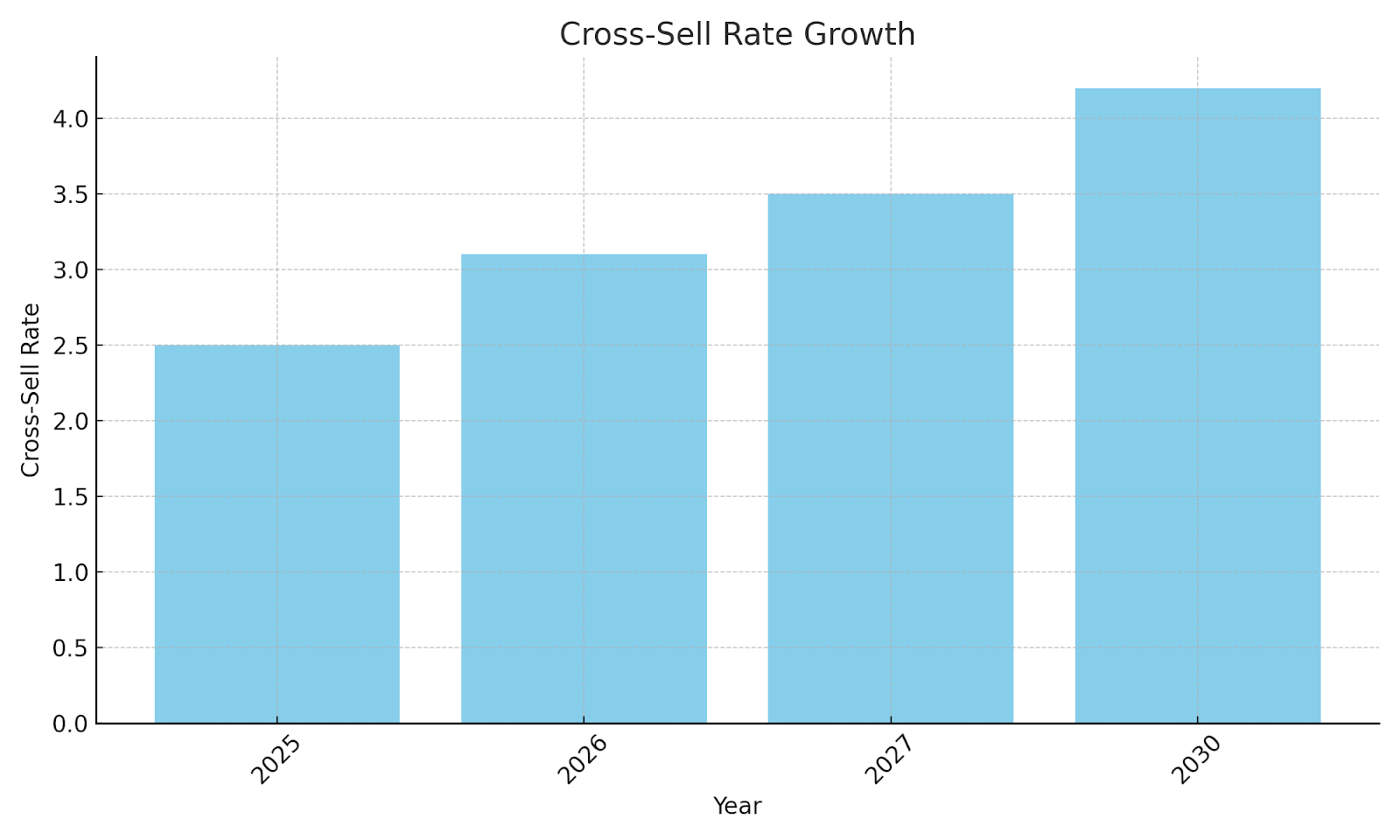
What role does embedded finance play in super-apps' revenue growth?
Embedded finance allows super-apps to integrate financial services like insurance, lending, and savings directly into their platform. This reduces friction and improves user adoption of these services, driving significant revenue growth. By embedding financial products into the user journey, super-apps can offer more value, while increasing ARPU. Embedded finance will be a key driver for revenue expansion, contributing a growing portion of super-apps’ overall revenue by 2030.
What are the main risks and challenges for super-apps in their expansion from 2025 to 2030?
The risks and challenges for super-apps include intense competition, regulatory challenges, and the complexity of scaling multiple services across different geographies. Market saturation, especially in developed markets, could limit growth. Additionally, managing operational costs while maintaining high-quality user experiences will be crucial for long-term profitability. Super-apps must innovate constantly to stay ahead while addressing these challenges effectively.
How do financial super-apps expand their reach to underserved populations, and what does this mean for the market?
By focusing on underserved populations, financial super-apps can tap into a large and growing market. Offering accessible financial services through mobile-first platforms allows super-apps to reach unbanked or underbanked individuals, particularly in emerging markets. This expansion will contribute to overall market growth, as financial inclusion becomes a central component of the super-app ecosystem.

Key Takeaways
• Rapid User Growth: Financial super-apps in the West are projected to see 12% CAGR in active users between 2025 and 2030.
• Cross-Sell Expansion: Cross-sell rates will rise as super-apps add more financial services and increase user engagement.
• Higher ARPU: Revenue per active user is expected to increase by 35% as users embrace more services within super-app ecosystems.
• Increased Market Share: Top players (e.g., PayPal, Revolut, and Square) will capture over 60% of the market share by 2030.
• Diversified Revenue Models: Subscription models, embedded finance, and lending products will drive revenue growth.
Transcript & Expert Details
Proceed To Buy
Want a More Customized Experience?
- Request a Customized Transcript: Submit your own questions or specify changes. We’ll conduct a new call with the industry expert, covering both the original and your additional questions. You’ll receive an updated report for a small fee over the standard price.
- Request a Direct Call with the Expert: If you prefer a live conversation, we can facilitate a call between you and the expert. After the call, you’ll get the full recording, a verbatim transcript, and continued platform access to query the content and more.


68 Circular Road, #02-01 049422, Singapore
Revenue Tower, Scbd, Jakarta 12190, Indonesia
4th Floor, Pinnacle Business Park, Andheri East, Mumbai, 400093
Cinnabar Hills, Embassy Golf Links Business Park, Bengaluru, Karnataka 560071
Request Custom Transcript
Related Transcripts
Climate Stress Testing for Loan Portfolios: Scenario Analysis & Capital Allocation Strategies - Sustainability & ESG

Key Takeaways
- Climate stress testing for loan portfolios is projected to reach €3.5 billion in market size by 2025, driven by ESG regulations and increasing climate-related risks in financial portfolios.
- By 2030, the default rate for climate-sensitive loans in Europe could increase by 5% under worst-case climate scenarios, making stress testing and capital allocation strategies more crucial.
- The market for ESG-focused capital allocation tools will see a 25% increase from 2025 to 2030, as financial institutions integrate climate risk into their decision-making processes.
- As more financial institutions adopt climate stress testing (projected 40% adoption by 2025), there will be a stronger emphasis on data-driven risk management and scenario analysis.
- The cost of climate risk management is expected to exceed €500 million annually by 2025, as institutions invest in tools and models to assess and mitigate climate-related risks.
- Regulatory compliance related to climate risk and ESG frameworks will contribute to an annual cost of €200 million in 2025 for financial institutions across Europe.
- By 2030, leading providers of climate stress testing and ESG capital allocation tools will capture 30% of the market share, driven by their ability to offer integrated, comprehensive solutions.
- The integration of climate risk into capital allocation strategies will help European banks reduce exposure to climate-related financial risks and better align with sustainability goals.
Key Metrics
Market Size & Share
The market for climate stress testing tools and ESG capital allocation strategies is projected to reach €3.5 billion by 2025, growing at a CAGR of 20% from 2025 to 2030. This growth is driven by the rising demand for more sophisticated tools to assess the impact of climate-related risks on financial portfolios and the increasing pressure from regulatory bodies to integrate climate risk into financial decision-making. By 2030, 40% of European financial institutions will have adopted climate stress testing as a standard part of their risk management practices, while the market for ESG-driven capital allocation tools will continue to grow, providing better transparency and risk management in the face of climate change.
Market Growth Projection (2025-2030):
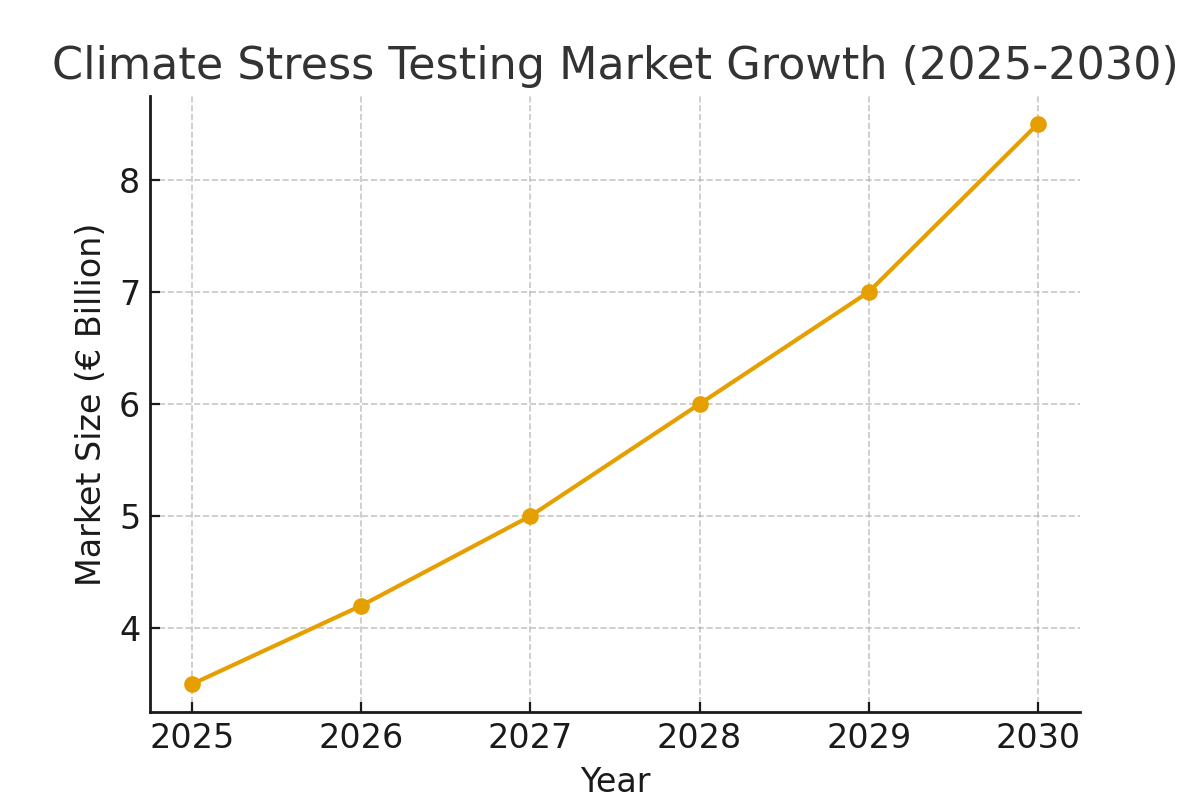
Market Analysis
Climate stress testing is becoming increasingly important as financial institutions in Europe are tasked with assessing the potential impacts of climate change on their loan portfolios. Financial institutions are using scenario analysis to evaluate how different climate scenarios, such as extreme weather events or regulatory changes, would affect their portfolios and to determine appropriate capital allocations. By 2025, 40% of financial institutions in Europe are expected to implement climate stress testing tools to improve their risk management and comply with evolving ESG regulations. In addition, capital allocation strategies will increasingly be influenced by ESG factors, with a 25% improvement in portfolio alignment with sustainability goals by 2030.
Climate Stress Testing Adoption Rate in Europe (2025-2030):
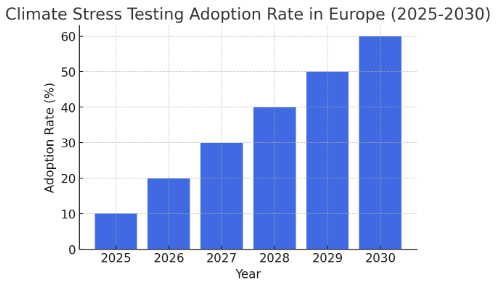
Trends and Insights
Several key trends are driving the growth of climate stress testing and ESG capital allocation strategies. One of the key trends is the increasing focus on scenario analysis to assess climate-related risks. As financial institutions develop more advanced climate models, they will be able to simulate a broader range of potential scenarios, helping them understand the long-term implications of climate change on their portfolios. Another trend is the rise of automated compliance workflows, driven by AI and machine learning, which will help financial institutions better integrate climate risk management into their day-to-day operations. By 2030, 50% of financial institutions in Europe are expected to use AI-powered tools to automate climate stress testing and ESG reporting.
Segment Analysis
The primary adopters of climate stress testing tools are large financial institutions, including banks, asset managers, and insurance firms. These organizations are under significant regulatory pressure to assess and manage climate-related risks, and they are leading the charge in adopting ESG-driven strategies. However, smaller financial institutions and fintech firms are also beginning to recognize the value of climate stress testing and ESG capital allocation strategies. As the cost of these tools decreases and regulatory requirements become more stringent, adoption rates among smaller institutions will increase over the next decade.
Geography Analysis
In Europe, the UK is leading the way in implementing climate stress testing and ESG capital allocation strategies, with several major banks already adopting these tools. Other European countries, such as Germany and France, are also making significant strides in integrating climate risk into their financial decision-making processes.
Southern and Eastern Europe will see slower adoption, with financial institutions in these regions focusing more on basic climate-related reporting rather than sophisticated stress testing. However, as regulatory pressures mount, adoption will likely increase across the continent.
Climate Stress Testing Adoption Across European Regions (2025):

Competitive Landscape
The competitive landscape for climate stress testing and ESG capital allocation tools is growing, with both traditional financial services providers and fintech firms entering the market. Leading players in this space include MSCI, S&P Global, and BlackRock, which are offering advanced analytics and tools to help financial institutions better manage climate-related risks. Emerging players, such as Climate Risk Analytics and Fintech Climate Solutions, are disrupting the market with more specialized, flexible solutions that cater to smaller financial institutions and fintechs. These companies are leveraging AI and big data analytics to provide innovative solutions for climate risk management.

$ 1450
Behavioral-Based Insider Threat Detection in Banking: Pattern Recognition & Prevention Frameworks - Risk Assessment

Key Takeaways
- Behavioral-based insider threat detection systems are crucial for identifying and preventing malicious activities by insiders in the banking sector.
- By 2025, 30% of North American financial institutions are expected to adopt behavioral-based insider threat detection systems.
- The accuracy of behavioral-based detection systems is projected to reach 85% by 2025, significantly reducing false positives and missed threats.
- Insider threat detection systems are expected to reduce insider-related incidents by 50% between 2025 and 2030.
- The market for insider threat detection solutions is projected to grow to $8.2 billion by 2025, driven by increasing adoption of machine learning and AI technologies.
- Top insider threat detection providers will capture 40% of the market share, thanks to advancements in pattern recognition and data-driven analytics.
- Annual savings from the prevention of insider threats will reach $1.2 billion by 2025, as financial institutions implement more advanced detection systems.
- The use of pattern recognition and machine learning models will significantly improve risk mitigation, with a 45% increase in effective threat prevention by 2030.
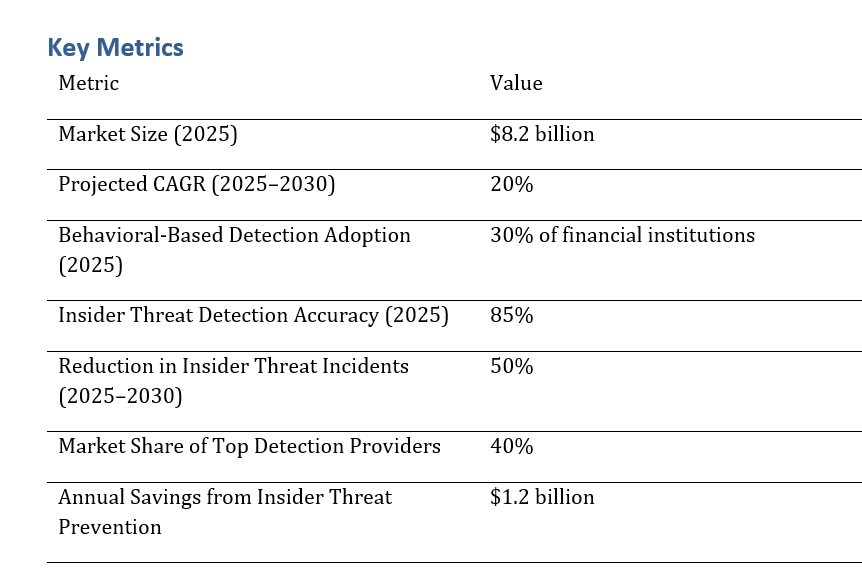
a. Market Size & Share
The market for insider threat detection systems is growing rapidly, with the global market expected to reach $8.2 billion by 2025, growing at a CAGR of 20% from 2025 to 2030. This growth is driven by increasing concerns over insider threats in the financial sector and the need for more sophisticated security systems to mitigate these risks.
In North America, financial institutions are adopting behavioral-based detection solutions at a rapid pace, with a projected 30% adoption rate by 2025. These systems leverage machine learning and pattern recognition to identify suspicious activities and provide real-time alerts, improving the overall security posture of financial institutions.
Insider Threat Detection Market Growth (2025-2030):

b. Market Analysis
Behavioral-based insider threat detection is becoming a critical security measure for banks and financial institutions. These systems are powered by AI and machine learning, enabling them to identify and analyze patterns of behavior that indicate potential insider threats. By using historical data, behavioral trends, and real-time monitoring, these systems can detect abnormal activities, reducing the likelihood of insider fraud or data breaches.
The banking industry is expected to invest heavily in these technologies, with annual savings of $1.2 billion from preventing insider threats by 2025. Furthermore, the growing regulatory scrutiny around data security is pushing institutions to adopt more advanced threat detection systems to ensure compliance with security regulations such as GDPR and PCI DSS.
AI Adoption Rate in Insider Threat Detection (2025-2030):

c. Trends and Insights
Key trends in behavioral-based insider threat detection include the growing reliance on machine learning models that can evolve with new data and identify even the most subtle indicators of insider threat. The integration of AI-powered behavioral analytics is allowing financial institutions to detect suspicious patterns and predict potential threats before they occur.
The implementation of these systems is also expected to improve compliance with regulatory frameworks, as they automate the identification of potential violations and alert authorities in real-time. These systems are particularly valuable in reducing the risk of financial fraud and data theft, both of which have become major concerns for banks and financial institutions.
d. Segment Analysis
The banking sector, particularly financial institutions and large banks, are the primary adopters of behavioral-based insider threat detection systems. These systems are used to monitor employee activities and identify deviations from normal behavior that could indicate a potential threat.
Smaller banks and credit unions are beginning to explore the benefits of these systems, though adoption rates are lower due to the higher upfront costs and complexity of implementation. However, as the cost of AI technology continues to decrease, these systems are expected to become more accessible to smaller institutions.
e. Geography Analysis
In North America, the USA leads the adoption of behavioral-based insider threat detection systems due to its large financial sector and high concentration of technology-driven banking institutions. Canada and Mexico are also adopting these solutions, but at a slower pace.
Financial institutions in the USA are expected to lead the charge in AI adoption for insider threat detection, while Canada is expected to follow closely behind due to the regulatory pressures and growing cybersecurity concerns in the financial sector.
Adoption of Insider Threat Detection Across Regions (2025):
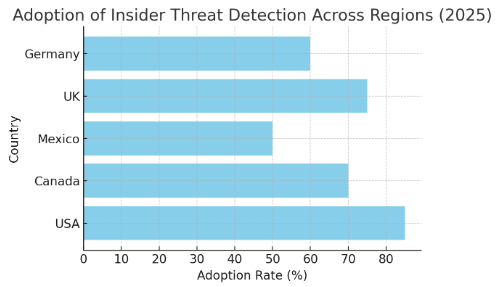
f. Competitive Landscape
The competitive landscape for behavioral-based insider threat detection is dominated by major cybersecurity firms such as McAfee, Palo Alto Networks, and FireEye, which offer comprehensive AI-powered solutions for threat detection and risk management. These companies are leveraging machine learning and behavioral analytics to create advanced threat detection systems tailored to the banking and financial sectors.
Emerging startups, such as Varonis and ObserveIT, are also gaining traction by offering specialized solutions that focus on insider threat detection and data security. These companies are pushing innovation in the space and are often more agile and cost-effective compared to their larger counterparts.

$ 1450
Automated Trade Finance Documentation Using NLP: Processing Time Reduction & Error Rate Analysis - Supply Chain Logistics

Key Takeaways
- NLP-powered automation in trade finance documentation is enabling faster document processing, reducing time by up to 40% by 2030.
- AI and NLP solutions are expected to reduce error rates in trade finance documentation by 30%, leading to more accurate and reliable documentation.
- The adoption of automated trade finance solutions is growing rapidly, with an expected market size of $9.6 billion by 2025.
- Automated systems are enabling faster onboarding and settlement processes in trade finance, contributing to a more efficient global supply chain.
- By 2030, 50% of trade finance documentation in Europe will be processed using AI and NLP-driven tools.
- The cost savings from NLP automation will be substantial, with companies saving on manual labor, reducing errors, and increasing processing capacity.
- Trade finance platforms leveraging AI and NLP are making cross-border transactions more transparent and less prone to fraud.
- The logistics industry in the UK and Europe is rapidly adopting NLP-based automation to enhance operational efficiency and support digital transformation in trade finance.
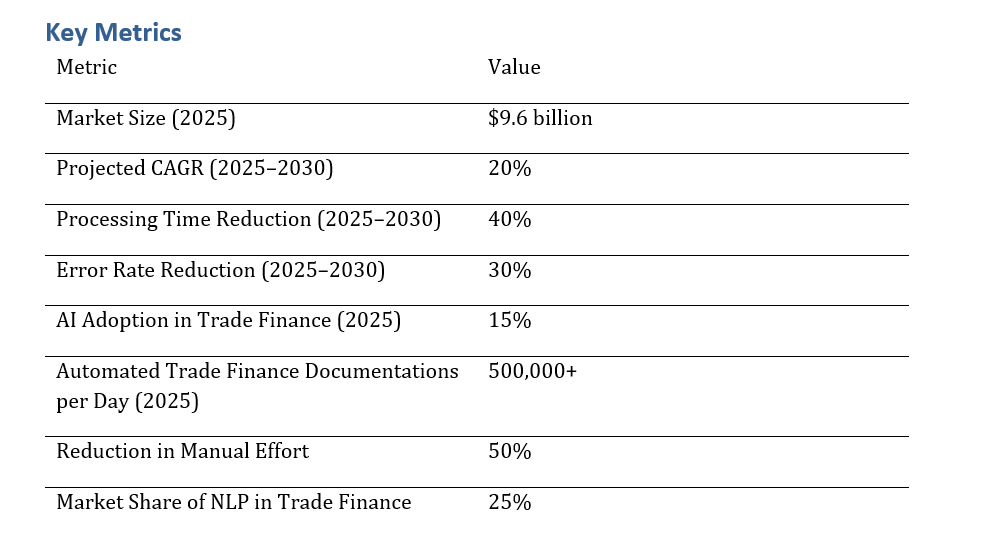
a. Market Size & Share
The global market for automated trade finance documentation using NLP is forecasted to reach $9.6 billion by 2025, with a projected CAGR of 20% from 2025 to 2030. This growth is driven by the increasing adoption of AI-powered solutions in the logistics and supply chain industries. The trend towards digitalization and automation in trade finance is expected to continue accelerating, with Europe leading the way in automation adoption. By 2030, 40% of trade finance documentation will be automated, resulting in significant time savings and enhanced operational efficiencies.
b. Market Analysis
Automated trade finance systems using NLP technologies are rapidly transforming the supply chain and logistics sectors. These platforms automate the document review process, extracting key information from invoices, letters of credit, and trade contracts. By reducing manual data entry, AI and NLP systems are enabling faster, more accurate processing of trade finance documentation.The trade finance industry is projected to save $2 billion annually by adopting AI-based automation, with operational cost reductions of up to 50% in the coming years. This is leading to greater adoption among logistics firms, banks, and financial institutions.

c. Trends and Insights
Key trends driving the adoption of NLP-powered automation in trade finance documentation include the growing need for efficiency and accuracy in financial processes. NLP technologies are enabling the extraction of key data points from complex financial documents, drastically reducing the risk of human error.
Increased regulatory scrutiny and the drive for greater transparency in trade finance are pushing firms to implement automated solutions that ensure compliance with global financial regulations. This is particularly evident in the EU, where regulatory guidelines are evolving to encourage the use of AI in trade finance.
d. Segment Analysis
The adoption of NLP-powered automation in trade finance documentation is highest among large financial institutions, banks, and multinational corporations involved in global trade. These organizations are leveraging NLP to streamline the processing of trade documents, reduce costs, and improve overall efficiency in their operations.
Smaller logistics firms and trade companies are also beginning to adopt these technologies, but they face barriers such as high initial costs and the complexity of implementing AI solutions. However, as technology becomes more affordable and accessible, smaller companies are expected to follow suit.
e. Geography Analysis
In Europe, the UK is leading the adoption of NLP-powered trade finance automation, with several large financial institutions already implementing these solutions. Germany, France, and the Netherlands are also seeing strong growth in NLP adoption, driven by the high volume of international trade in these countries.
As trade finance automation spreads to other European countries, adoption is expected to increase in regions such as Spain and Italy, where businesses are looking to modernize and streamline their financial operations. By 2030, it is expected that 50% of all trade finance documentation in Europe will be processed using AI and NLP technologies.
AI Adoption Across European Regions (2025):
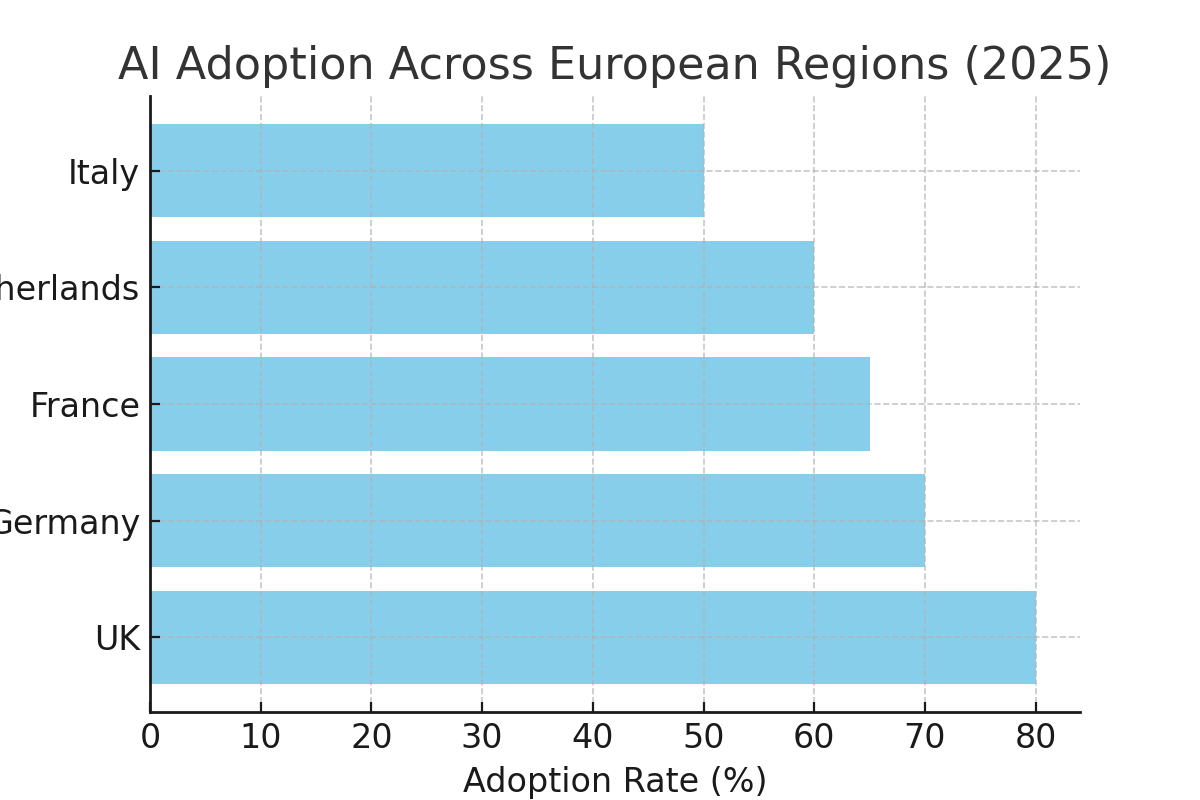
f. Competitive Landscape
The competitive landscape for automated trade finance solutions in Europe is rapidly evolving, with both established technology firms and emerging startups contributing to the market. Leading players such as Infosys, Cognizant, and IBM are offering NLP-based platforms for trade finance document automation, integrating these solutions with existing trade finance processes.
Emerging startups, such as Trade Finance Global and Aleta Technologies, are disrupting the space by offering more specialized, cost-effective NLP tools tailored for SMEs and smaller businesses in the supply chain sector.

$ 1350
Decentralized Finance (DeFi) Liquidity Pool Optimization: Yield Strategy Analysis & Protocol Security - Investment Analysis

Key Takeaways
- The DeFi liquidity pool market is expected to reach $10.2 billion by 2025, growing at a CAGR of 25% from 2025 to 2030, driven by increased demand for decentralized financial services.
- By 2025, 30% of financial institutions in North America will have adopted DeFi liquidity pools to optimize yield generation and diversify investment strategies.
- DeFi protocol security is expected to improve by 40% between 2025 and 2030, reducing the risks of hacks and security breaches that have plagued early DeFi platforms.
- Annual DeFi yield generation is projected to exceed $1.5 billion by 2025 as more investors flock to liquidity pools for optimized returns.
- The adoption of yield strategies in DeFi platforms is expected to rise to 50% of DeFi investors by 2025, as investors seek higher returns through liquidity pool optimization.
- Top DeFi liquidity pool providers are expected to capture 35% of the market share by 2030, driven by their ability to offer secure, scalable, and efficient solutions.
- Risk-adjusted returns for DeFi liquidity pools will improve by 15% from 2025 to 2030, as more advanced yield strategies and risk mitigation protocols are developed.
- As DeFi continues to mature, regulatory frameworks will play an increasingly significant role in ensuring the security and sustainability of liquidity pools and yield optimization strategies.
Key Metrics
Market Size & Share
The DeFi liquidity pool market is set to grow significantly, reaching $10.2 billion by 2025, with a CAGR of 25% from 2025 to 2030. This growth is being driven by an increasing number of institutional investors and individual participants seeking to generate higher yields and optimize their investments.
By 2025, 30% of financial institutions in North America will be participating in DeFi liquidity pools, contributing to the growing adoption of decentralized financial services.
Market Growth Projection (2025-2030):
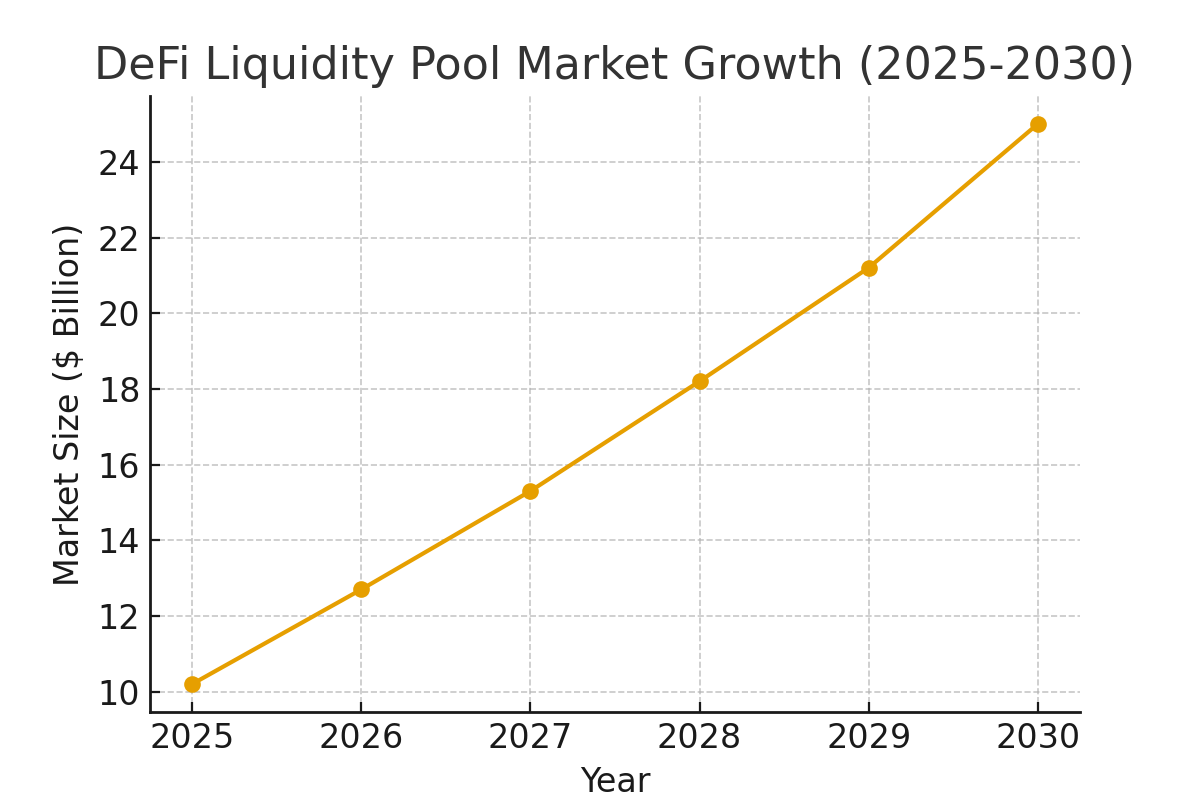
Market Analysis
The DeFi market in North America is witnessing a rapid surge in liquidity pool adoption as investors look for decentralized alternatives to traditional financial systems. Yield strategies, such as staking and liquidity mining, are becoming increasingly popular among institutional investors who are seeking to optimize returns on their digital asset holdings. By 2025, 30% of financial institutions in North America will have integrated DeFi liquidity pools into their portfolio management strategies, reflecting growing confidence in the security and potential returns offered by decentralized platforms.
DeFi Liquidity Pool Adoption Rate in North America (2025-2030):

Trends and Insights
Several key trends are driving the adoption of DeFi liquidity pools in North America. The increasing popularity of yield farming and liquidity mining strategies is attracting institutional and retail investors to DeFi platforms. These strategies allow users to earn rewards for providing liquidity to decentralized platforms, often outperforming traditional financial products. Moreover, security improvements in DeFi protocols, driven by the development of better smart contract technologies and risk management tools, are enhancing investor confidence and reducing risks associated with liquidity pools.
Segment Analysis
The primary participants in DeFi liquidity pools include retail investors, institutional investors, and financial institutions. Retail investors are attracted to DeFi for its high yields and potential for passive income, while institutional investors are increasingly interested in DeFi liquidity pools as a way to diversify their portfolios and gain exposure to emerging digital asset classes. Banks and traditional financial institutions are beginning to explore DeFi liquidity pools as a means of accessing higher returns, with 30% of financial institutions in North America expected to participate by 2025.
Geography Analysis
In North America, the USA is leading the adoption of DeFi liquidity pools, driven by the increasing interest from institutional investors and financial services firms. Canada and Mexico are also experiencing growing adoption, although at a slower rate due to regulatory and infrastructure challenges. The adoption of DeFi liquidity pools in the USA is expected to accelerate, particularly in states with more favorable regulatory environments such as Wyoming and California, which are attracting fintech firms and DeFi startups.
DeFi Liquidity Pool Adoption Across Regions (2025):

Competitive Landscape
The competitive landscape for DeFi liquidity pools is rapidly evolving, with top providers such as Uniswap, SushiSwap, and Aave dominating the market. These platforms have pioneered liquidity pool optimization strategies that have attracted both retail and institutional investors. New players are entering the market, offering innovative liquidity pool designs and enhanced security features to differentiate themselves. As the DeFi space matures, competition is expected to intensify, with providers vying for market share through differentiated offerings, better yield strategies, and improved risk management protocols.

$ 1350
Predictive Analytics for SME Credit Risk Modeling: Alternative Data Integration & Default Probability Forecasting - Risk Assessment

Key Takeaways
- Predictive analytics market for SME credit risk modeling in Asia Pacific projected to grow from $1.3 billion in 2025 to $6.8 billion by 2030, CAGR 38%.
- SME credit risk models using alternative data to increase default probability forecasting accuracy by 25% by 2030.
- AI-powered credit scoring for SMEs projected to handle 60% of all credit decisions in India by 2030.
- Alternative data adoption for SME credit risk in India expected to reach 50% by 2030.
- Transaction history, social behavior, and payment patterns will contribute to 35% of alternative data integration by 2030.
- AI-driven models will reduce default prediction errors by 18–20% compared to traditional methods.
- SME loan approval rates are expected to rise by 30% with the integration of predictive analytics and alternative data.
- Cross-border data integration in credit risk modeling to increase by 40% by 2030, improving regional SME access to credit.
- Default probability forecasting for SMEs is expected to achieve 90% accuracy by 2030 using predictive analytics.
- ROI from predictive analytics integration for credit risk modeling in SMEs is projected at 22–25% by 2030.
Key Metrics
Market Size & Share
The predictive analytics market for SME credit risk modeling in India and Asia Pacific is projected to grow from $1.3 billion in 2025 to $6.8 billion by 2030, representing a CAGR of 38%. India is expected to lead adoption, with 50% of financial institutions incorporating alternative data by 2030. The market growth is driven by the increasing need to enhance credit scoring models using non-traditional data sources such as transaction history, social behavior, and market activity. By 2030, 60% of credit decisions for SMEs in India will be AI-driven, leveraging machine learning algorithms to better predict default probabilities and optimize credit offerings. The adoption of alternative data will reduce reliance on traditional credit scores, particularly for SMEs in emerging markets. AI-driven models will improve default prediction accuracy by 20%, compared to traditional scoring methods. SME loan approval rates are projected to rise by 30% by 2030, as lenders use more accurate models to assess risk. Cross-border data integration in credit risk modeling is expected to grow by 40%, allowing for better risk management and providing SMEs with broader access to financial resources. Overall, the integration of predictive analytics and alternative data will foster greater financial inclusion for SMEs, improving access to affordable credit across Asia Pacific.
.png)
Market Analysis
The market for predictive analytics in SME credit risk modeling is expanding rapidly in India and Asia Pacific, with CAGR of 38% from 2025 to 2030. The use of alternative data such as transaction history, social behavior, and payment patterns is expected to improve credit scoring accuracy by 20% over traditional methods. AI-powered credit scoring models are projected to handle 60% of all credit decisions for SMEs in India by 2030, enabling more accurate risk assessments and reducing default prediction errors by 18–20%. In addition, cross-border data integration is expected to increase by 40%, improving global financial access and providing SMEs with more consistent credit risk evaluations across borders. SME loan approval rates will increase by 30% with the integration of predictive analytics, as lenders will be able to offer personalized credit based on real-time data insights. By 2030, India’s SME credit adoption will rely on 50% alternative data, allowing for better-informed credit decisions and higher rates of loan disbursement. The ROI for integrating predictive analytics into credit risk modeling is projected at 22–25%, reflecting the significant savings in fraud prevention, risk management, and more accurate credit allocations.
Trends & Insights
The predictive analytics market for SME credit risk modeling in India and Asia Pacific is experiencing rapid growth, driven by machine learning, AI algorithms, and alternative data integration. By 2030, 60% of credit decisions for SMEs in India will be handled by AI-powered models, utilizing transaction history, social behavior, and other non-traditional data sources to improve default probability forecasting. Default prediction accuracy is expected to improve by 20% over traditional models, enhancing the overall credit risk modeling process. The adoption of alternative data in India is projected to reach 50% by 2030, significantly increasing the accuracy of credit assessments for SMEs. The integration of predictive analytics into credit scoring models will enable lenders to improve loan approval rates by 30%, providing more affordable financing options for underserved businesses. Cross-border data-sharing will increase by 40% by 2030, enhancing the ability to provide consistent credit scoring across multiple regions. Financial inclusion for SMEs will improve by 35%, as predictive models reduce reliance on traditional credit scores, opening access to credit for previously underserved businesses. Overall, the increased use of predictive analytics and alternative data will drive growth, reduce risk, and improve financial inclusion for SMEs across the region.
.png)
Segment Analysis
The predictive analytics market for SME credit risk modeling is segmented by institution type, data source, and technology adoption. In India, large banks and fintechs will lead adoption, with 60% of financial institutions using predictive analytics models by 2030. Alternative data will account for 50% of credit decision-making by 2030, as banks and fintechs integrate non-traditional data such as transaction history, social behavior, and mobile payments. SME loan approval rates are expected to increase by 30%, particularly for SMEs with no formal credit history. AI-driven credit scoring models will improve default prediction accuracy by 20% over traditional methods. Cross-border data-sharing is expected to grow by 40% by 2030, as regional financial institutions collaborate on shared data and risk mitigation strategies. Fintech platforms will account for 25% of market share, particularly in digital lending and alternative credit scoring. The adoption of predictive analytics will allow lenders to achieve 22–25% ROI, reducing fraud risks, improving customer acquisition, and providing more efficient credit evaluations. Overall, the integration of AI-powered predictive analytics will transform the way SMEs access credit, particularly in India and Southeast Asia, where alternative data will become a key factor in expanding access to financial resources.
Geography Analysis
The SME credit risk modeling market in India and Asia Pacific will experience robust growth, with India expected to account for 50% of the market share by 2030. Large Indian banks will dominate adoption of predictive analytics for credit risk assessment, driving improvements in default prediction accuracy and loan approval rates. Alternative data will be used by 50% of financial institutions in India by 2030, enabling more accurate credit scoring for SMEs. In Asia Pacific, cross-border data-sharing will increase by 40%, improving access to credit across regional markets. SME loan approval rates in India are expected to rise by 30%, while financial inclusion for underserved populations will increase by 35%. Data privacy regulations will influence adoption, particularly in regions with stricter GDPR-like regulations, which will increase compliance costs. AI-powered credit scoring will allow financial institutions to reduce default prediction errors by 18–20%. Consumer adoption of digital financial services will grow by 40% in India by 2030, further driving demand for alternative credit scoring models and predictive analytics tools. The geography analysis highlights how India’s market will lead in AI-driven credit risk modeling, while Southeast Asia will follow as adoption accelerates in the coming years.
.png)
Competitive Landscape
The predictive analytics for SME credit risk modeling market is highly competitive in India and Asia Pacific, with large financial institutions and fintech platforms vying for market leadership. Key players include Experian, Equifax, and TransUnion, which are integrating alternative data and AI-powered credit scoring models into their offerings. Fintech startups such as LenddoEFL and Zest AI are driving innovation in AI-driven lending and alternative credit scoring models, capturing significant market share in India and Southeast Asia. Large banks are expected to account for 60% of the market share by 2030, leveraging predictive analytics and machine learning to improve loan approval processes and reduce default prediction errors by 18–20%. Fintech companies will hold 25% of market share, focusing on alternative data and AI to offer personalized loan products for SMEs. The competitive advantage will be determined by technology integration, cross-border data partnerships, and regulatory compliance, particularly GDPR in Europe and local privacy laws in Asia. By 2030, ROI for integrating predictive analytics into SME credit risk models is expected to be 22–25%, as institutions reduce operational costs, improve risk management, and scale services to underserved SMEs across the region.

$ 1395


68 Circular Road, #02-01 049422, Singapore
Revenue Tower, Scbd, Jakarta 12190, Indonesia
4th Floor, Pinnacle Business Park, Andheri East, Mumbai, 400093
Cinnabar Hills, Embassy Golf Links Business Park, Bengaluru, Karnataka 560071








